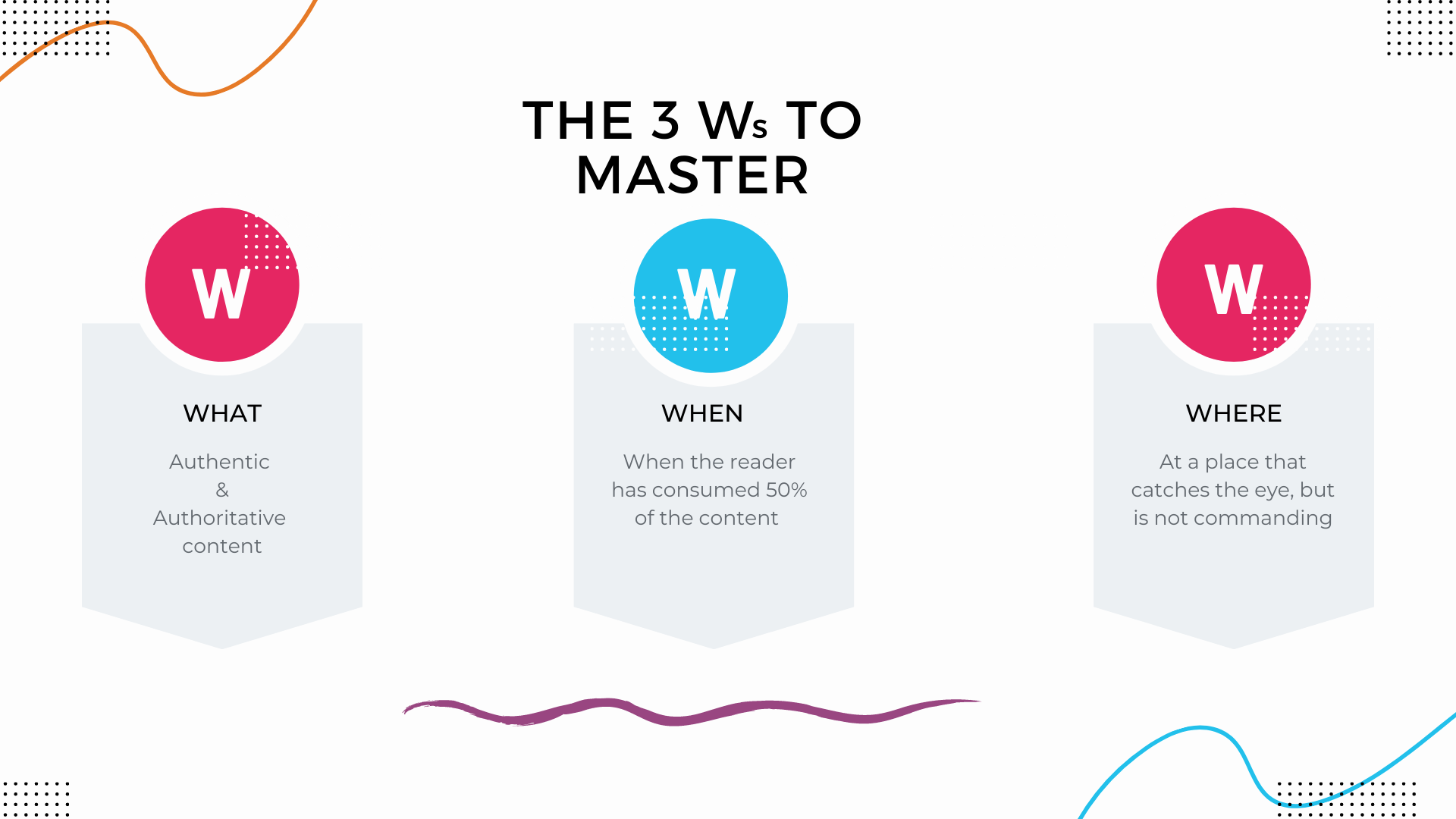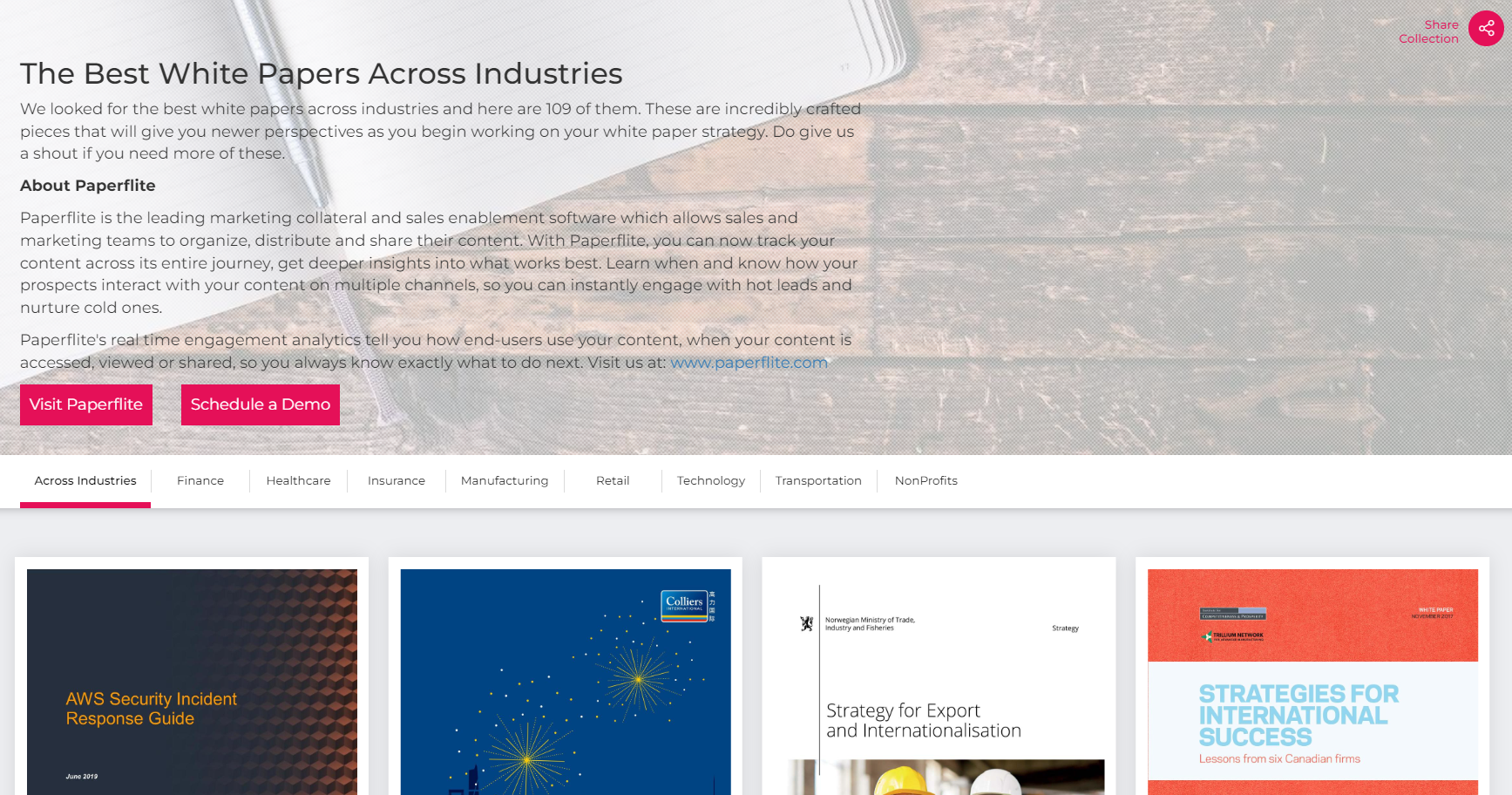How to Generate leads with gated content?
Gating is the process of….wait - fill in your mail id, phone number, food preferences, height, weight, etc and you’ll be able to read further.

Okay.Okay. Just Kidding. You don’t have to fill in anything HERE to find out!
Coming to the matter at hand, debating this market led concept can lead to two things - thorough understanding where you realise how to gate and if to gate, or immediate disposal where you just gate everything you create. We want you to achieve the former.
As marketers, we are trained to hide our expertise behind forms, under the pretext of lead generation. But we also have to realise that we live in an era where consumers no longer want to type out private details in order to gain access to exclusive pieces of content, unless they know the underlying value.
So, should we still follow the bandwagon? Should we let it die? OR should we align it with the tech advancements we have today in order to make it a win win?
Let’s dive right in.
Gating is an oldie but a goodie. Hence, we are here to tell you that gating is a necessary evil (at least in the reader’s eye). But what we, as marketers, can do is, make it a pleasant experience for them.
Imagine you are narrating the most exhilarating experience that has ever happened in your life, but you are met with so many unwanted questions or worse, suggestions. That is exactly what a reader feels when you block and nudge them.,
What is Content Gating?
Content gating is a marketing strategy of hiding (hence the word “gating”) your premium content behind a requirement, such as a user providing their email address.
It’s a clever tactic to generate leads while also creating a privilege of exclusivity in your content, enticing readers to venture beyond this gate.
Why do you need to gate your content ?
You’ve worked extremely long hours to come up with a piece of content that you think adds so much value to the reader. You are super proud of your contribution to the entire field of marketing. But something feels weird when you just give it all away, for free. Hence you build up a wall and gate. You make it a forbidden piece and hide it behind tactical forms with the notion that this will get you leads.
Gating is not just about collecting contact details; it signals a reader giving attrition to your skill. By choosing to gate some of your content, you’re basically filtering through the noise, and only inviting those who truly appreciate what you’re offering. Instead of making information harder to get, you’re making sure it gets to the audience that will benefit from it the most.
If done correctly, gating can enhance the value of your content by making it a sought-after commodity where there’s a plethora of freely available information.
And now that you have done all that, you get the leads.
How many times have these leads become fruitful conversions?
More often than not, you are left with what feels like a huge pile of (you know what). This triggers disappointment.
It impacts workflow and all this somehow adds up and reflects negatively on your hard worked copy.
We heard that heavy sigh!
But, we still stand by what we said earlier. Gating is necessary. And gating does bring you leads.
Let’s explain,
How content gating improves Lead Generation ?
- Performance Measurement: Gating content makes it a measurable asset. By looking at the number of people that are willing to trade their information for access, you’re essentially gaining an insight into your content’s appeal. This allows you to refine your content in a way that attracts an even bigger audience.
- Quality Lead Capture: Imagine trying to find free information on the World Wide Web- easy, right? But what if, the information you’re really looking to get at is gated and you have to show enough interest to fill out a form and truly commit. This is what builds potential relationships that should be nurtured. The readers who take this step are already engaged with your content and you need to seize this opportunity.
- Nurturing Opportunities: This is where the real work begins. Content being tucked away behind form fills gives you contacts, thereby giving you access. It enables you to know, pursue and close deals. Business to business (B2B) marketing for the most part depends on gating. With that access you can send daily email drips, newsletters, create campaigns, share content that converts and simply just speak with a prospect.
- Measuring Content Performance: Lastly, gating allows you to deeply analyze your content. In retrospect, looking at the parts of gated content that produce the most leads, you can identify the topics in most demand. This will allow you to tailor your content strategy according to your audience’s preferences. These insights will also drive your marketing efforts in the right direction.
What, when and where to gate your content?

Where should you gate content?
Tailor your gating process based on your audience. You can set up gates that appear only after a visitor has engaged with a certain percentage of your content. This means you're not asking for their details upfront but waiting until they've shown a genuine interest.
It's like offering a second cup of coffee to someone who's already enjoyed the first; it just makes sense. This ensures that your gating is not just smart, it’s practically telepathic.
Or In the case of sharing content that is of high intent or confidentiality it expected for the gating form to be placed up front and its better to have the gating form in the beginning
If you sure of the content you can easily decide on where to place the gating form in platforms like cleverstory it enables you to make use of both types of gating form, hence helps you with strategic lead generation.
When should you gate content?
Timing is everything, not just in comedy, but when it comes to gating too. Instead of asking how long the audience has spent reading your content, you should be asking where the audience is on their journey with you. Early on, when they’re just getting to know you, keep the gates open.
Let them wander, explore, and taste the appetizers. Then slowly and steadily, as they move from casual browsing to interest-driving prospects, that’s your chance. This is when they are looking to dig deeper into your proposed solutions and would be more willing to exchange their information.
Tailored forms appear at a time when we know what a visitor is consuming. We are no mind readers here but we have painstakingly engineered a website that will do it for us.
What has to be done with the Generated Leads?
Once you’ve mastered the art of content gating and the leads start coming in, this is where the real dance initiates. These are the steps to convert your leads into loyal advocates for your brand
Leads Segmentation:
Think of your leads like different types of plants; they need varying amounts of nourishment to thrive. Segmenting your leads into various groups- be it by demographics, behaviors, interests, or where they are in the buying stage- allows you to adjust your strategy accordingly.
By catering to each group’s unique needs and categorizing efficiently, you’re more likely to see your leads bloom into honest customers.
Continued Engagement:
Each interaction with your leads should be like a step in a long, engaging conversation. Be it through email, social media, webinars, or personalized content, the goal should be to keep the dialogue flowing.
Always aim to establish your credibility and building trust with the lead, this in turn ensures that your brand remains at the forefront of their minds. Be the friend who’s always there, offer timely insights without overdoing it.
Sales Outreach:
Here’s where your sales team steps into the spotlight. Instead of leveraging a sales pitch, the goal is to show interest in understanding each lead’s needs and pain points.
This line of communication is what bridges marketing and sales, turning a lead into a real person in the database with specific needs that only your service can solve. Voila! You’re now more intimate, focused and tailored to create a deeper connection.
Conversion Tracking
This part is where you keep tabs on how the relationship is progressing. This step involves monitoring the leads through your sales funnel and analyzing key performance measures such as lead-to-customer conversion rates, average time to conversion, and lead source performance.
This helps you ensure a smooth lead management process and identify what works, what doesn’t, and where adjustments need to be made to improve your transitional processes.
Sales Closing
Finally, the moment of truth: persuading your qualified leads to make a purchase decision. This is not just about hard selling, it’s about understanding the motivations of your leads and proving to them why your solution is the be-all and end-all for their needs.
The most important part is crafting the perfect proposal. You should highlight to the lead why a future together (with your product) is a match made in heaven.
Content Gating best practices
Content gating serves as a strategic approach to lead generation, offering valuable insights in exchange for user information. The effectiveness of this strategy depends on its implementation, as with all things in life. The key is to balance lead capture with a positive user experience.
Prioritizing User Experience:
First and foremost, always make sure that you prioritize the user experience. This means that your content gate shouldn’t feel like a gate, wait am I saying that right? Yes! It should instead feel like a welcoming archway and respect the user’s time and perception of value.
Optimizing Form Length: When it comes to forms, think of Goldilocks: not too long, not too short, but just right. An extensive form may scare off potential leads, while one that is too brief might not gather enough information.
Leveraging Progression Profiling:
Progressive profiling is a refined approach to data collection, much like an engaging conversation that unfolds over time. This method ensures each question establishes a better understanding without overstepping boundaries.
Balancing Lead Generation with User Experience:
Achieving a balance between capturing leads and maintaining a seamless user experience is crucial. The request for information and the value of the gated content should compliment each other and resonate with the users.
Testing and Tweaking:
In this evolving digital landscape, the only constant thing is change. Regularly test different elements of your gating process, from the call to action to the form fields and even the type of content gated. Analyze the results and tweak your approach accordingly.
Why marketers use both gated and ungated content ?
By utilising gated and ungated material strategically, marketers may address every stage of the buyer's journey. While gated content increases interaction, generates leads, and guides prospective buyers towards a choice, ungated content establishes the foundation by fostering awareness and trust.
Ungated content is an open invitation to the world. It is content that is freely accessible without the requirement to exchange personal information. Consider it a sample platter at a gourmet shop, providing a taste of what's to come with no strings attached.
Its purpose is to seduce, educate, and engage new clients from the start of their journey. It's the handshake, the introduction, and the first step towards developing a relationship. Prospective customers are looking for answers to their preliminary concerns and queries.
Here, ungated content really shines, providing a free and easy opportunity for people to discover more about your company and its area of expertise. As beacons, blogs, infographics, and short videos entice people who are just casual browsing by offering value and building rapport without expecting anything in return.
With Gated content lies the deeper dive, content that is judged valuable enough to warrant a trade of data. It's similar to a secret recipe or a backstage pass, offered only to those who've shown enough interest to engage further.
This content is designed for prospects further along in their journey, those who've sampled the appetizers and are ready for a main course. As customers move from casual browsing to considering a solution, gated content comes into play.
It's here, in the consideration to decision stages, that the exchange of information for access becomes a fair proposition. Webinars, detailed guides, and comprehensive reports offer in-depth insights in exchange for a name, an email, or a phone number. This content helps qualify leads, distilling those who are genuinely interested and guiding them toward becoming well-informed decision-makers.
Examples of gated content
Whitepapers
Whitepapers are the heavyweights of content marketing, packed with detailed analysis, research, and insights. They're gated because they offer high-value information that positions your brand as a thought leader.
Present them as downloadable assets on dedicated landing pages, enticing visitors with summaries or snippets that hint at the ground breaking insights awaiting behind the form.
Here is an example of a gating collection of paperflite containing whitepapers across various industries:
" target="_blank">

Case Studies
Case studies showcase your successes, providing concrete examples of how your products or services have solved real-world problems. They're gated to capture leads at the consideration stage, who are interested in seeing evidence of your expertise.
Use them as a follow-up to blog posts or articles about related topics, directing interested readers to a form they can fill out to learn more about your victorious tales.
Templates
Templates are practical tools that offer immediate value, helping users to apply best practices in their own work. They're gated to attract leads who are actively seeking solutions, demonstrating your willingness to provide hands-on help.
Offer templates through targeted campaigns or as next steps in educational content, showing how these tools can address specific challenges or tasks.
Product Demos
Demos give a first hand look at how your product works, catering to prospects who are further down the funnel and considering a purchase. They're gated to ensure that those requesting a demo are genuinely interested.
Integrate demo requests into product pages, encouraging visitors to take the next step in their buyer's journey by experiencing your solution in action.
Webinars
Webinars are interactive and informative sessions that delve into topics of interest, offering real-time engagement. They're gated to build a qualified audience of attendees who value the opportunity to learn and interact.
Promote webinars through social media and email campaigns, directing potential attendees to a sign-up page where they can register to join the session.
Market Research, Predictions, Trends, and First-Party Results
This content provides cutting-edge insights and data, valuable to professionals looking to stay ahead in their industry.
It's gated to capture the contact details of those who value this foresight.
Share teasers of your findings on social media and professional forums, linking to a gated download page for the full report or analysis.
eBooks
eBooks offer comprehensive guides on specific topics, providing a deep dive into subjects of interest. They're gated to attract leads seeking in-depth information and willing to engage more deeply with your content.
Feature eBooks on your website, complemented by blog posts or articles that introduce the eBook's topic, guiding readers towards downloading the full guide.
Landing Pages
Landing pages themselves aren't gated, but they serve as the gateway to your gated content, designed to convert visitors by offering them something of value in return for their information.
Create compelling, focused landing pages for each piece of gated content, highlighting the benefits and unique insights that await behind the form.
Marketing or Sales Enablement Collaterals
These materials support your sales team by providing them with information that helps move prospects through the sales funnel. Gating these resources ensures they reach the hands of serious prospects.
Offer these as part of a nurture sequence or in response to specific inquiries, ensuring that those who access them are engaged and interested in how your solutions can help solve their problems.
Cleverstory - Breaking the monotony of gating
We not only tell a Cleverstory, but also ask Clever Questions.
When a reader goes through the Cleverstory platform there is no ‘form’ jumping up in front asking for contact details or a childhood pet’s name. Clearly not boasting here.
We have to admit, we do ask questions, but, we ask questions that will get the right answers.
Tailored forms appear at a time when we know what a visitor is consuming. We are no mind readers here but we have painstakingly engineered a website that will do it for us.
With Cleverstory a creator has complete control over what, when and where to gate. This can be customized based on usability patterns, opening up a whole new level of connection with the end user.
Here you can gate at the content level. Meaning, gating can be done individually to every piece of content shared with a prospect or you can gate the entire collection. This again can be modified. Content can be gated at any stage, the reader can read 50% of the piece and then you can place a gating form. Or choose to place the form right at the beginning, this smart call is the creators choice.
What’s more? There is absolutely no code required to create or gate. This is every marketer's dream come true, we hope. Gating forms can be created with minimal effort and can be cloned or edited at the source in order to repurpose them for multiple use cases. The creator can change the gating rules at any point of time. The edit can also be made at the source, it is a one step change.
Make Content That Is Bingeable And Not Boring
Gating content according to what and where the reader can benefit from is the base line to quality leads. This is where smart gating contributes a vantage point. Using this, rather, mastering this, gives you access to what actually converts.
Therefore, SMART GATING to the win!
With Cleverstory, you can create no code interactive content. This is an interactive content creation software built for marketers who refuse to send out boring documentations. Build insightful pages with no code design having the luxury to customise every step of the way.
Still not convinced? Book a demo right here to explore further.
